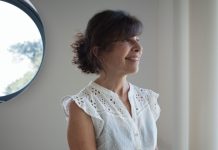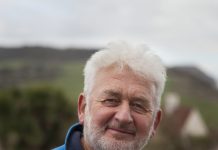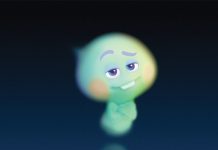Robin Mills met James Lovelock in Abbotsbury, Dorset
‘I was born in 1919, and spent the first 5 years of my life in Letchworth Garden City being brought up by my grandparents; I then went back to live with my parents in Brixton, who had an art shop. My Dad was a strange man in many ways; he was born in 1872, and when my grandfather died quite young, my grandmother was left with 13 kids to bring up alone. There was of course no support, no welfare, and with the threat of the workhouse, they all became hunter-gatherers. That meant that my father had almost zero schooling, was never taught to read or write as a child, but the need for survival meant that he had a wonderful knowledge of the natural ecology of the countryside. He was marvellous to go for walks with and learn about the habitat of animals and birds, and he was also a natural-born inventor. Later on when he managed to get a job at a gas works in London, the proprietor sent him to Battersea Polytechnic at his own expense, where he learned literacy and numeracy in his early twenties. What led him to open an art shop I’ll never know.
What led me into science were two things. For Christmas, aged 4, I was given a wooden box full of electrical odds and ends—wires, batteries, buzzers, etc.—and was told to see what I could make of it. I went round asking people why it was you needed 2 wires to pass a current when with things like gas or water a single pipe would do, and soon discovered I had to find that out for myself. The second thing was that my parents, having become quite arty, would spend Sunday afternoons visiting the V&A in South Kensington. Realising that I was completely bored with art galleries, my father sent me across the road to the Science Museum, where I was immediately fascinated. Aged 6, I was left entirely to my own devices, and that really set me off. However, at age 9 I went to Grammar School, and hated it. I had looked forward to learning science there, but they made it so dull; fortunately I still could visit the Science Museum.
When the Great Depression arrived in the 1930’s, I was able to get a scholarship so that I could stay on at school; the art shop was really a dead loss, so my parents were quite hard up. After school I was very lucky to get a job as a lab assistant with a photography firm, who were involved in the whole photographic process, from making silver gelatin, to dyes for colour printing. We youngsters were thrown in at the deep end, but it meant that I learned more science there that I could ever have at university, because it was hands on; we learnt how to do things right. I’m not superstitious, but luck has played a large part in how my life progressed. That job was one bit of luck, and the boss of the firm sent me to evening classes at Birkbeck College to get a degree, paying the fee. But he said that when I’d got my degree, I’d be sacked, because he couldn’t afford to employ graduates. That sounds a bit harsh, but I thought it was a reasonable policy; however, although I was doing well at Birkbeck, during a visit to Manchester I’d fallen for a girl, and I decided I’d like to finish my chemistry degree there. I’d only been there a couple of weeks when the principle called me in to his office and accused me of cheating in a test. I’d got all the answers right, twice running, and nobody had done that before. It took me quite a time to convince him that I could do gravimetric analyses almost in my sleep, thanks to my abundant practical experience.
After university, the next bit of luck was being offered a job at the National Institute for Medical Research; they were looking for someone with good practical skills, and I was recommended. It was wartime, and I remember the director Sir Henry Dale interviewing me for the job: he said, “My boy, forget science, we’re not going to do any science here. That will have to wait until after the war. The work’s all ad hoc problems, which preferably can be solved yesterday.” I absolutely loved that, and some of the work was here in Dorset. One of the many mad ideas Churchill had was setting fire to the sea off the beaches, in the event of invasion. We were able to demonstrate, off Studland, that even with a massive amount of fuel on fire floating on the sea, you could still tow a wooden boat through the flames largely unscathed. That ended that idea, and saved the nation a huge amount of precious fuel.
I worked for the MRC for 20 years, a secure, pensionable and quite well paid job. You’d have thought I’d be mad to leave a job like that with four children growing up, but a letter arrived one day from NASA in America. NASA was then only 3 years old, and the letter was from the Director of Space Flight Operations, inviting me to be an experimenter on their lunar and Mars missions. I had invented instruments like the Electron Capture Detector, which can measure pesticides in the atmosphere in parts per trillion, and incidentally enabled Rachel Carson to write Silent Spring. NASA heard about my inventions, and wanted tiny, light instruments to go on spacecraft, to measure surface properties. I got involved with the biology experiments being carried out to see if there was life on Mars, and I thought the biologists’ methods were completely crazy. The boss said that if I didn’t think much of their methods I’d better come up with a better idea, and soon—or else. It dawned on me that all you had to look for was an entropy reduction on the planet, and you could do this by analysing the atmosphere and seeing if the gases in it reacted with one another—or if they were in equilibrium. Now, in the Earth’s atmosphere there’s a lot of oxygen, and methane, and in sunlight they react with one another, and would reduce and disappear, unless there was something on the Earth making huge quantities of these gases. Because there isn’t any lifeless process that will do it, it can only come from biological activity. And as that means there must be life to maintain that equilibrium, the atmosphere on Mars must be lifeless. It also means that biological life on Earth is not only making the gases in the atmosphere, but also regulating them at a balanced level which can support life. The astronomer Carl Sagan, with whom I once shared an office, also suggested to me that if my theory was correct, why has the Earth’s temperature remained stable enough since life began for life to continue, when the temperature of the sun during that time has increased greatly. To me, that means that our biosphere, by regulating the levels of CO2 and methane in the atmosphere, also controls the temperature. My hypothesis, which my friend and one-time near neighbour William Golding suggested we call Gaia, after the Greek earth mother goddess, wasn’t well received by biologists, who felt it was contrary to Darwinism—which it isn’t. And it was also given a spiritual spin by some of the “New Age” people, which created difficulties for my reputation as a scientist.
I’m quite sure it’s impossible to predict the future of our climate when there are so many unknown factors; although there’s no doubt human activity is having an effect. What is known as the Little Ice Age, which lasted about 100 years in the Middle Ages due to reduced sunspot activity, is now thought to be quite likely to happen again. If it does, we may well be glad of a bit of global warming.’









